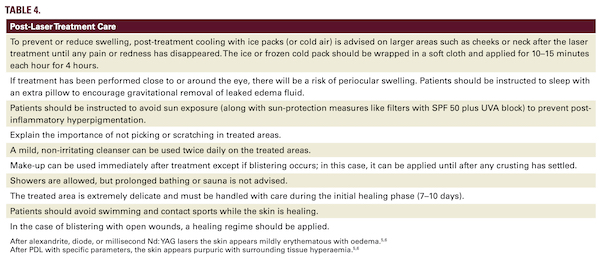
who treat facial areas should choose suitable alternatives that are safe for use in these areas.26,29,30
The use of stabilized HOCl for pre-, peri-, and post-procedure management may have several benefits.26,29,30 Stabilized HOCl is highly active against bacterial, viral, and fungal microorganisms that have significantly harmful activity against biofilm and increases oxygenation of wound sites to improve healing.26,29,30
Complications from laser treatment are reduced by operator education and experience and may include pain, purpura, bruising, and swelling.5,6,11,12,18
The treatment of pain and anesthesia should be at the treating physician’s discretion and is dependent on the patient.
Section 4: Post-Procedure
Information on adverse events and measures that can be taken is given in Table 3. Purpura or bruising may occur immediately after the procedure but will subside over 7–10 days.5,6,11,12,17,18
The common areas most likely to develop post procedure edema are under the eyes and in the neck.5,6,11,12,17,18 The edema usually subsides within 3–5 days if ice packs or cold packs are regularly applied. Parallel and post-cooling will also diminish the amount of edema.5,6,11,12,17,18
Discoloration, however, rare, may be caused by overtreatment, but may also occur if the treatment was without events. Grey or pale white discoloration of the epidermis is a sign of early dermal damage indicating inappropriately high radiant exposures and will last only a few seconds.11,12
Partial- or full-thickness wounds can result from the ablative laser treatment, whereas nonablative laser may cause small epidermal wounds.
A post-procedure infection causes pain and swelling and may delay wound healing, even leading to scarring.16 Therefore when edema and crusting occurs, it may require an in-office evaluation.6
Our literature searches showed there is a lack of consistency or standard in post-care therapeutic measures such as for wound healing.6 The panel agreed that in the case of blistering with open wounds, a healing regime should be applied.
Currently, gentle cleansers or an antimicrobial spray26 are advised for at least two weeks post-procedure.6 Evidence suggests skincare, immediately before the procedure, and throughout the healing phase, can stimulate healing.31 An antimicrobial spray containing HOCl can be applied during all stages of laser procedures.26 From pre-procedure for removing excess make-up through peri-procedure (spraying on the face/ cold packs) to long-term post-procedure for infection prevention and stimulating healing.26,29-31 When used after resurfacing, the spray is immediately post-procedure applied and combined with an emollient.26 For at-home care, the spray may be applied 3–4 times a day during the first-week post-procedure.26
The use of stabilized HOCl for pre-, peri-, and post-procedure management may have several benefits.26,29,30 Stabilized HOCl is highly active against bacterial, viral, and fungal microorganisms that have significantly harmful activity against biofilm and increases oxygenation of wound sites to improve healing.26,29,30
Complications from laser treatment are reduced by operator education and experience and may include pain, purpura, bruising, and swelling.5,6,11,12,18
The treatment of pain and anesthesia should be at the treating physician’s discretion and is dependent on the patient.
Section 4: Post-Procedure
Information on adverse events and measures that can be taken is given in Table 3. Purpura or bruising may occur immediately after the procedure but will subside over 7–10 days.5,6,11,12,17,18
The common areas most likely to develop post procedure edema are under the eyes and in the neck.5,6,11,12,17,18 The edema usually subsides within 3–5 days if ice packs or cold packs are regularly applied. Parallel and post-cooling will also diminish the amount of edema.5,6,11,12,17,18
Discoloration, however, rare, may be caused by overtreatment, but may also occur if the treatment was without events. Grey or pale white discoloration of the epidermis is a sign of early dermal damage indicating inappropriately high radiant exposures and will last only a few seconds.11,12
Partial- or full-thickness wounds can result from the ablative laser treatment, whereas nonablative laser may cause small epidermal wounds.
A post-procedure infection causes pain and swelling and may delay wound healing, even leading to scarring.16 Therefore when edema and crusting occurs, it may require an in-office evaluation.6
Our literature searches showed there is a lack of consistency or standard in post-care therapeutic measures such as for wound healing.6 The panel agreed that in the case of blistering with open wounds, a healing regime should be applied.
Currently, gentle cleansers or an antimicrobial spray26 are advised for at least two weeks post-procedure.6 Evidence suggests skincare, immediately before the procedure, and throughout the healing phase, can stimulate healing.31 An antimicrobial spray containing HOCl can be applied during all stages of laser procedures.26 From pre-procedure for removing excess make-up through peri-procedure (spraying on the face/ cold packs) to long-term post-procedure for infection prevention and stimulating healing.26,29-31 When used after resurfacing, the spray is immediately post-procedure applied and combined with an emollient.26 For at-home care, the spray may be applied 3–4 times a day during the first-week post-procedure.26






